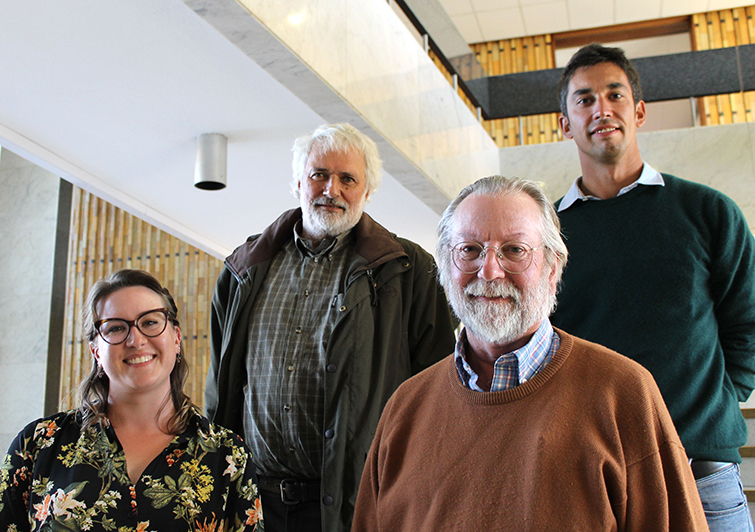25 July 2019
|
Story Leonie Bolleurs
|
Photo Leonie Bolleurs
 At a public seminar, Understanding human evolution through the study of past environments in the Free State, presented by the UFS Department of Plant Sciences, were, from the left, front: Kristen Wroth, Britt Bousman; back: Prof Louis Scott, mentor in the UFS Department of Plant Sciences, and Michael Toffolo.
At a public seminar, Understanding human evolution through the study of past environments in the Free State, presented by the UFS Department of Plant Sciences, were, from the left, front: Kristen Wroth, Britt Bousman; back: Prof Louis Scott, mentor in the UFS Department of Plant Sciences, and Michael Toffolo.
Florisbad, a thermal spring situated 45 km northwest of Bloemfontein on the edge of a large dry saltpan, is a well-known fossil site that used to be a large lake where giant buffalo, blue wildebeest, and hippos roamed thousands of years ago. Today, this fossil-bearing spring is not only a tourist attraction and a venue for weddings, but also an established
quaternary research station that has attracted several palaeo-scientists since the 1930s, following the discovery of a remarkable human cranium and other fauna.
Studies of past environments Three international researchers studying different aspects of archaeology at this and other sites in the Free State, recently presented lectures at the UFS to a multidisciplinary group of academics in plant sciences, geology, geography, and environmental management.
These lectures are part of the ongoing collaboration regarding fossil plant (pollen), fauna, and archaeological studies between the University of the Free State (UFS), the
National Museum, and universities abroad.
Florisbad, a key site for understanding the appearance of modern environments as well as modern humans in Southern Africa, is the focus of the investigations of all three visiting scientists, aiming to provide a better understanding of past Free State environments where human evolution has taken place.
Michael Toffolo, a junior research chair from the
University of Bordeaux Montaigne in France, focuses on the reconstruction of site-formation processes, palaeo-environments, and ancient human activities based on the study of the micro-morphology of archaeological deposits. He has been working in Southern Africa since 2013. The title of his lecture was: Reconstructing Pleistocene environments in the Free State by looking at the microscopic sedimentary record.
Fluoride-preserved bonesFlorisbad is widely known for the discovery of an archaic modern human skull of c. 260 000 years old. According to Toffolo, the human probably died, and the remains was left at the spring by the hyenas. The bones consequently absorbed fluoride from the spring water, which counteracted decomposition and helped to preserve it.
Britt Bousman talked about middle and late Pleistocene terraces and archaeology in the Modder River Valley. He has worked in Southern Africa for the past 43 years and started his collaboration with researchers from the UFS and the National Museum in 1985. They have worked together at several sites, investigating palaeo-environments. Bousman teaches Archaeology in the
Department of Anthropology at the Texas State University. While most scientists study early human records in rock shelters, especially those near the coast where seafood was harvested by prehistoric people, he is one of only a few researchers who studies the evolution of early human behaviour in central South Africa in the context of their activities in the open environment.
“Rock shelters are good spaces for human behaviour,” says Bousman. He believes, however, that the Modder River area is a better space to study how humans have survived on the land under changing climatic conditions in the long term; for example, how they hunted and slaughtered animals. This can be seen from the many artefacts they left, such as spearheads, scrapers, etc. Interesting animal remains were also found, such as the bones of an extinct giant zebra at the Erfkroon site along the Modder River, with a head measuring 63 cm compared to that of a current zebra, which measures 54 cm. The only complete horn core of an extinct giant wildebeest was also found at the site.
The first chemistsAccording to Bousman, technology changed in the Stone Age and included the production of more grinding stones, indicating that humans collected plants and grinded them. Observations of modern plant-collecting activities suggested that not many plant foods needed grinding. Bousman proposes that different plant components may have been grinded for medicinal mixtures, therefore these ancestors may have assumed the role of chemists.
Kristen Wroth, a postdoctoral researcher in the
Geoarchaeology Working Group at the
University of Tübingen, Germany, presented a lecture on early human-environment interactions and ancient pyro technology. She uses a suite of micro-archaeological techniques such as phytolith (microscopic plant silica) analysis, micromorphology, and FTIR to understand both human and Neanderthal behaviour and to reconstruct how local environments have changed in space and through time.